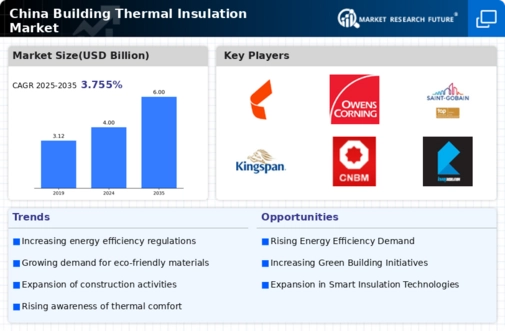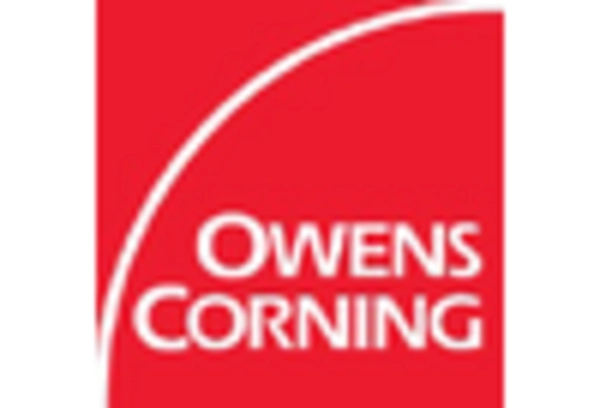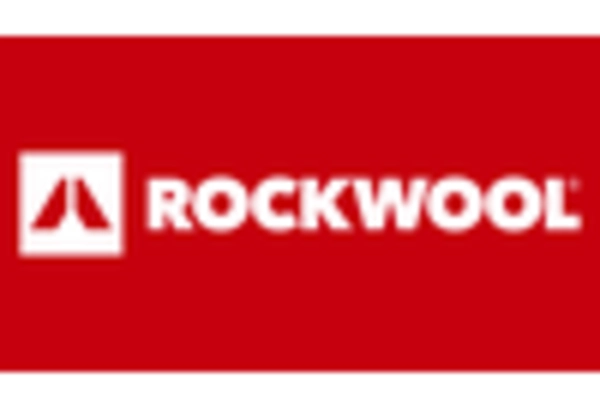Rising Construction Activities
The surge in construction activities across urban areas in China significantly influences the building thermal-insulation market. With urbanization continuing at a rapid pace, the demand for residential and commercial buildings is escalating. In 2025, the construction sector is projected to grow by approximately 8%, leading to an increased need for effective thermal insulation solutions. Builders are increasingly recognizing the importance of insulation in achieving energy efficiency and comfort in new constructions. This trend is likely to drive the adoption of advanced insulation materials, as developers seek to comply with energy efficiency regulations and meet consumer expectations. The building thermal-insulation market stands to gain from this construction boom, as more projects incorporate insulation as a fundamental component.
Consumer Awareness of Sustainability
There is a growing consumer awareness regarding sustainability and energy conservation in China, which is becoming a significant driver for the building thermal-insulation market. As individuals become more informed about the environmental impact of their choices, they are increasingly demanding energy-efficient homes and buildings. This shift in consumer behavior is prompting builders and developers to prioritize thermal insulation in their projects. In 2025, it is anticipated that around 60% of new residential projects will incorporate sustainable insulation materials. This trend not only enhances the market for thermal insulation but also aligns with the broader goals of reducing carbon footprints and promoting eco-friendly practices. The building thermal-insulation market is likely to thrive as consumers continue to advocate for sustainable living.
Increasing Energy Efficiency Standards
The push for enhanced energy efficiency standards in China is a pivotal driver for the building thermal-insulation market. The government has implemented stringent regulations aimed at reducing energy consumption in buildings, which has led to a growing demand for high-performance insulation materials. As of 2025, it is estimated that energy-efficient buildings could reduce energy use by up to 50%. This regulatory environment encourages builders and developers to invest in advanced insulation solutions, thereby propelling market growth. The building thermal-insulation market is likely to benefit from these standards, as they not only promote sustainability but also enhance the overall value of properties. Consequently, manufacturers are focusing on developing innovative insulation products that meet these evolving standards, further stimulating market dynamics.
Government Incentives for Energy Efficiency
Government incentives aimed at promoting energy efficiency are significantly impacting the building thermal-insulation market. In China, various financial incentives, such as tax breaks and subsidies, are being offered to encourage the adoption of energy-efficient building practices. These incentives are designed to stimulate investment in thermal insulation technologies, making them more accessible to builders and developers. As of 2025, it is estimated that these government programs could lead to a 20% increase in the adoption of insulation materials in new constructions. The building thermal-insulation market is likely to benefit from these initiatives, as they not only lower the cost barrier for high-quality insulation but also align with national goals for energy conservation and sustainability.
Technological Innovations in Insulation Materials
Technological advancements in insulation materials are playing a crucial role in shaping the building thermal-insulation market. Innovations such as aerogels, vacuum insulation panels, and phase change materials are emerging, offering superior thermal performance and energy efficiency. These advanced materials are becoming increasingly popular among builders and architects, as they provide effective solutions for energy conservation in buildings. In 2025, it is projected that the market for high-performance insulation materials will grow by 15%, driven by these technological innovations. The building thermal-insulation market is likely to see a shift towards these cutting-edge materials, as they not only improve energy efficiency but also contribute to the overall sustainability of construction projects.

















Leave a Comment